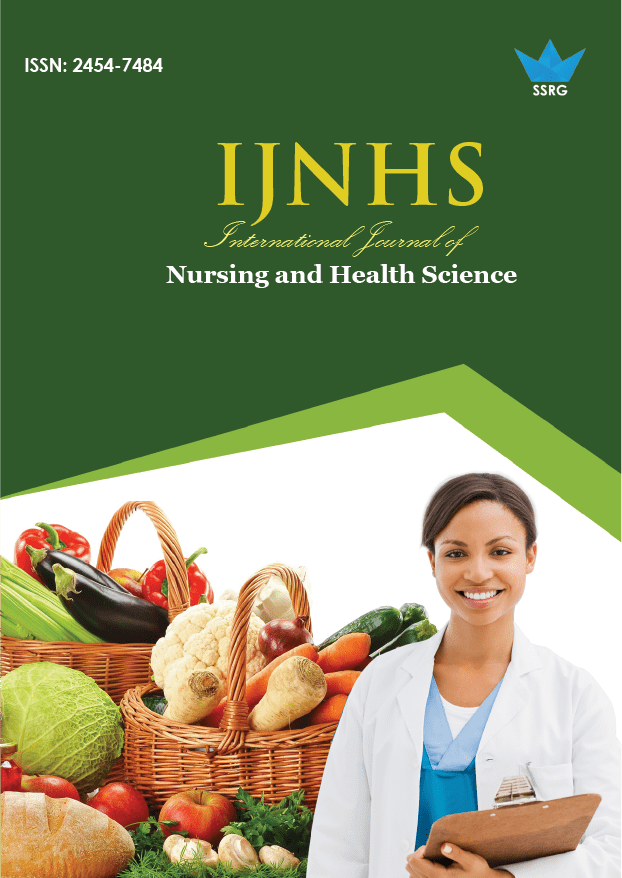Exploring Nursing Students’ Attitudes and Knowledge in Caring for People with Disabilities

| International Journal of Nursing and Health Science |
| © 2021 by SSRG - IJNHS Journal |
| Volume 7 Issue 2 |
| Year of Publication : 2021 |
| Authors : Rebecca Kronk, Susan Williams, Cassidy Kaczor, Ashley McDanald |
How to Cite?
Rebecca Kronk, Susan Williams, Cassidy Kaczor, Ashley McDanald, "Exploring Nursing Students’ Attitudes and Knowledge in Caring for People with Disabilities," SSRG International Journal of Nursing and Health Science, vol. 7, no. 2, pp. 8-11, 2021. Crossref, https://doi.org/10.14445/24547484/IJNHS-V7I2P102
Abstract:
Literature reveals that content in nursing curricula specific to disability health care is limited; poor communication, lack of competence, negative attitudes, and quality of care by nursing staff are concerns raised by people with disabilities (PWDs).
A. Purpose: Explore the knowledge, attitudes, and comfort level of pre-licensed nursing students in caring for PWDs.
B. Method: Nursing students (N = 124) received a pre-post course survey collecting quantitative and qualitative data. Educational interventions included a focused lecture and an authentic encounter with a simulated patient consultant with a disability.
C. Results: Two survey domains improved: working with PWD’s in a clinical setting (p = .000) and positive impressions of self-concepts of PWD (p = .019). All survey items shifted positively; 41% of survey items statistically improved (alpha < .05). Post course themes shifted from self-concern to patient advocacy.
D. Conclusion: Educational interventions can better be prepared nurses in caring for PWDs.
Keywords:
disability care, educational intervention, nursing student
References:
[1] World Health Organization. WHO global disability action plan 2014-2021: better health for all people with disability.,(2015). https://www.who.int/disabilities/actionplan/en/
[2] Hughes K, Bellis MA, Jones L, et al. Prevalence and risk of violence against adults with disabilities: a systematic review and meta-analysis of observational studies. Lancet. 379(9826) (2012) 1621-1629. doi:10.1016/s0140-6736(11)61851-5
[3] Jones L, Bellis MA, Wood S, et al. Prevalence and risk of violence against children with disabilities: a systematic review and meta-analysis of observational studies. Lancet. 380(9845) (2012) 899-907. doi:10.1016/s0140-6736(12)60692-8
[4] National Center on Birth Defects and Developmental Disabilities. (2020). https://www.cdc.gov/ncbddd/disabilityandhealth/features/disability-health-data.html
[5] Merten JW, Pomeranz JL, King JL, Moorhouse M, Wynn RD. Barriers to cancer screening for people with disabilities: a literature review. Disabil Health J. 8(1) (2015) 9-16. doi:10.1016/j.dhjo.2014.06.004
[6] Okoro CA, Hollis ND, Cyrus AC, Griffin-Blake S. Prevalence of disabilities and health care access by disability status and type among adults — United States, (2016). MMWR Morb Mortal Wkly Rep. 2018;67:882-887.
[7] Newton RH, Krebs A. Bridging the theory-practice gap using simulation to teach care of patients with disabilities. Teach Learn Nurs. 15(4) (2020) 233-236. doi:https://doi.org/10.1016/j.teln.2020.04.003
[8] Smeltzer SC, Robinson-Smith G, Dolen MA, Duffin JM, Al-MaqbaliM. Disability-related content in nursing textbooks. NursEducPerspect. 31(3) (2010) 148-155.
[9] Smeltzer SC, Avery C, Haynor P. Interactions of people with disabilities and nursing staff during hospitalization. Am J Nurs. 112(4) (2012) 30-37.
[10] Kronk R, Colbert AM, Smeltzer SC, Blunt E. Development of prelicensure nursing competencies in caring for people with disabilities through Delphi methodology. Nurse Educ. 45(3) (2020) E21-E25.
[11] Symons A, Fish R, McGuigan D, Fox J, Akl E. Development of an instrument to measure medical students' attitudes toward people with disabilities. Intellect DevDisabil.50(3) (2012) 251-260. doi:10.1352/1934-9556-50.3.251
[12] Smeltzer SC, Ross JG, Mariani B, et al. Innovative approach to address disability concepts and standardized patients with disability in an undergraduate curriculum. J Nurs Educ. 57(12) (2018)760-764. doi:10.3928/01484834-20181119-11

 10.14445/24547484/IJNHS-V7I2P102
10.14445/24547484/IJNHS-V7I2P102